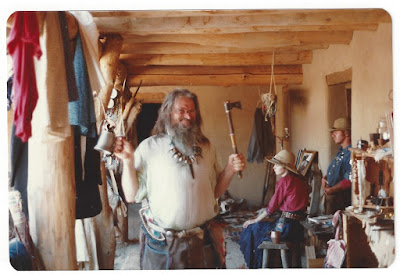Old Bill Williams
The
end of the revolutionary war was not the end of conflict or chaos, and heading
west sounded like a good idea. In his younger years Old Bill was a preacher,
bent on missionary work.

He translated the bible into the Osage language,
 and and was the interpreter for the 1825 treaty between the Osage and the United States.
But in the end, it was the Osage who converted him rather than the other way around.
and and was the interpreter for the 1825 treaty between the Osage and the United States.
But in the end, it was the Osage who converted him rather than the other way around.
 He married an Osage woman named Wind Blossom, and fathered two daughters, Mary Ann,
and Sarah. After that, even though he turned his back on the white man’s civilized
ways, he sent his daughters to school in Kentucky. They both ended up married
to the same man. First, Mary became the wife of John Allan Mathews. Upon her
death, John married Sarah. They had a deep connection and kept in close contact with the Osage people.
He married an Osage woman named Wind Blossom, and fathered two daughters, Mary Ann,
and Sarah. After that, even though he turned his back on the white man’s civilized
ways, he sent his daughters to school in Kentucky. They both ended up married
to the same man. First, Mary became the wife of John Allan Mathews. Upon her
death, John married Sarah. They had a deep connection and kept in close contact with the Osage people.
Sarah’s grandson, John Joseph Mathews became an historian for the Osage tribe. He studied at the University of Oklahoma,
Oxford University and the University of Geneva, and after serving as a flight
instructor during World War I, Old Bill William's great grandson served on
the Osage Tribal Council, and in 1938 he founded the Tribal Museum.
Uncle Dick Wootton Kit Carson
with his companion Jesus Silva
Uncle Dick Wootton as I knew him.
Old Bill traveled in esteemed company including such
notables as Kit Carson, Uncle Dick Wooten, and John C. Frémont. But because he had a
gift for languages, he spent more of his life with the varied Native American tribes
than with other mountain men. A skilled trapper and natural born leader, he
never sought fame or a captain’s title. He explored for the sake of exploring,
and loved what he called “an innocent frolic”. He seemed to be of a dual personality,
looked upon by some as treacherous and near crazy, and by others as kindly and
trustworthy. Wherever he went, he was steeped in controversy, with a penchant for mischief,
and mysticism, including the belief in reincarnation.
John C. Fremont
Bent's Fort reconstructed
Here he ran into Uncle Dick Wootton, and asked him to be their guide over the pass, but was turned down. Moving on to Pueblo, Frémont next came across Old Bill Williams who agreed to give it a go. But as the unrelenting snow continued, with no signs of letting up, Williams eventually advised Frémont to turn back.

Unfortunately, Fremont continued on, and ten members of the expedition were lost to starvation and exposure. Old Bill's group not being among them.
Rather than admit to his own failings, Frémont blamed all on Old Bill accusing him of incompetence, premeditated treachery, and even cannibalism. Truth be told, they would have been in even more dire straights without him. Old Bill never got a chance to refute these terrible claims.
It is surmised the band of Utes who killed Old Bill did not recognize him at the time. Later when they realized who he was, the gave him a chief's burial.
For more details on Old Bill's life, read Favour's excellent book, from whence came a good deal of this wonderful information.








No comments:
Post a Comment